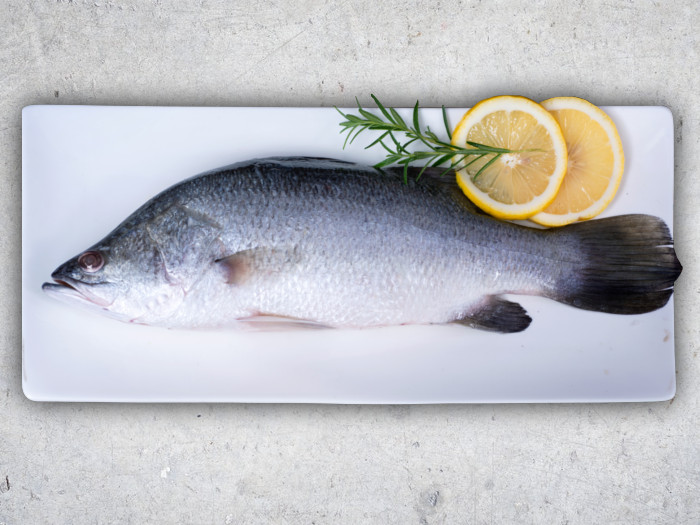Barramundi has several impressive health benefits which may include its possible ability to lose weight, balance cholesterol levels, prevent diabetes, ensure growth and repair, improve eye health, and strengthen bones.
What is Barramundi?
Barramundi is a fish from the Latidae family with the scientific name Lates calcarifer. The name actually means large-scaled river fish and is taken from the Australian Aboriginal language. Also known as the Asian sea bass, it is perhaps mostly found in Southeast Asia, Papua New Guinea, and some parts of Northern Australian waters. Its other names are giant perch, palmer, cockup, nairfish, bekti, and Australian seabass. Barramundi is a large fish with white, flaky flesh and a moderate flavor. [1] [2]
The fish is widely used in culinary preparations throughout Asia, and is quite versatile, and can probably easily replace any other type of bass or snapper in recipes. It is extensively used in Thai cuisine and is known as pla kapong there. Aside from its use in sustainable fish farming, there are also a wealth of possible high amounts of nutrients and minerals in barramundi that are very valuable for human health.
Barramundi Taste
Barramundi has a gentle, mild flavor that makes it appealing for all the seafood lovers in the world. The flesh of the fish is pearly pink in color and it has firm, large flakes and is easy to cook as it is possibly low in fats as compared to its other mates. Barramundi is pleasant to cook as it does not give out a strong odor, making it a favorite among people who want to wear the chef’s hat.

Barramundi is a type of seabass that’s native to Australia and the Indo-Pacific. Photo Credit: Shutterstock
Barramundi Nutrition Facts
Barramundi is known to be fairly rich in omega-3 fatty acids, healthy fats, protein, vitamin D, vitamin A, sodium, and potassium. These fish also seem to have a relatively low content of harmful chemicals like mercury and PCBs.
Health Benefits of Barramundi
Let’s take a closer look at the health benefits of barramundi.
May Have Low Mercury Levels
Barramundi is probably one fish that eats plankton for surviving, unlike other fish that gobble up smaller fish. This makes the palmer a healthier food option for all fish lovers as the mercury levels in this fish are plausibly very low. Moreover, you can perhaps relish this fish without any guilt of contributing to its extinction, perhaps because it relies on the freshwater organism plankton for its sustainability.
May Aid In Weight Loss
Barramundi may have nearly half the fat as compared to other fish such as salmon and it still provides an ample amount of nutrients like protein and minerals. This can be important for those looking to lose weight or shift their diet away from red meats without suffering the loss of essential nutrients that come with it. [3]
Might Protect Heart Health
Barramundi has an impressive balance of omega-3 and omega-6 fatty acids, and they seem to be close to the desired levels in the human body. In other words, barramundi can help balance cholesterol levels, thus possibly preventing atherosclerosis, obesity, and coronary heart diseases by perhaps reducing strain on the heart and arteries. [4]
May Improve Brain Health
The possibly high level of omega-3 fatty acids present in barramundi may make it a great addition to your diet. It may protect your brain and keep it healthy.
Can Help Manage Diabetes
Fish is generally considered to be a good choice for people living with diabetes, provided it is prepared properly. Barramundi, like several other fish, is a good source of omega-3 fatty acids. It can have positive health effects, provided it is consumed in moderation. A study published in the Nutrition Research journal also concludes that the antioxidant and anti-inflammatory properties of fish oil emulsions could help improve the quality of life in cases of diabetes. [5] [6] [7]
May Strengthen Bones
Like many fish species, barramundi, too, may have impressive levels of selenium, zinc, calcium, magnesium, and other essential minerals that the body needs to protect bones. Bone mineral density can prove to be a major issue as we age, so ensuring that we get high levels of these minerals, particularly the trace elements (like selenium), can be necessary for long-term health and strength. [8]
Might Improve Eye Health
Barramundi provides a high level of vitamin A, which is an antioxidant known to be specifically linked to eye and vision health. Vitamin A may help counteract the negative effects of free radicals that can cause macular degeneration and cataracts, thus potentially improving your vision and protecting it into the future. [9]
May Ensure Proper Growth
Barramundi is known to be rich in protein, which can be necessary for growth and development. The protein that comes from poultry and seafood is considered healthier than that in red meat and it can help contribute to our growth and may even help repair tissues, muscles, and bones. [10]
Easy Barramundi Recipe

Barramundi with Lemon Butter Sauce Recipe
Ingredients
- 2 Barramundi fillets
- 2 tsp olive oil
- 2 tsp of butter
- 1 clove minced garlic
- 2 tbsp lemon juice
- minced basil leaves
- salt (to taste)
Instructions
- To make barramundi with lemon butter sauce, sauté the minced garlic in butter till it becomes golden in color.
- Add the lemon juice, basil leaves, and salt to the garlic. Stir it and remove it from heat.
- Coat the fish fillets with olive oil and pan-fry them for about 3 minutes on medium heat. The edges of the fish should turn golden brown in color.
- Place the cooked fish on a serving plate and spoon the sauce on them. You can also add a couple of green peas alongside the fish and serve!

Word of Caution: Unlike other fish, which are contaminated with mercury and undesirable trace metals, barramundi has shown remarkable resistance to these contaminants. These fish eats plankton instead of other small fish, which is a major reason why it contains less mercury. More research is being done on barramundi, but no immediate concerns have surfaced about the safety of this delectable fish!
Fun fact: Originally all the barramundi fish are hermaphrodites and are born male and later change their gender when they reach maturity around 3-4 years of age.

